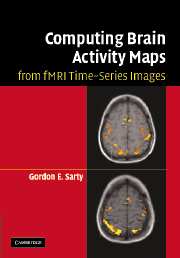6 - Conclusion
Published online by Cambridge University Press: 07 December 2009
Summary
There is no one best way to reduce fMRI data to brain activity maps, either activation maps or connectivity maps. The fMRI investigator must select a method of choice on the basis of a number of factors including software availability, speed of computation, ease of use and taste. The factor of taste can only have legitimacy if the investigator understands how each of the various approaches work and what the trade-offs are of using one method over another. The goal of this review was to give the investigator that overview of how the various available methods work. Once a method is selected, a deeper understanding of it may be obtained from the original literature. At that point investigators may be confident that, in focusing on a small number of methods for use in their laboratory or clinic, they have not overlooked a method that may have significant impact on the interpretations of their computed brain activity maps.
All of the methods reviewed here require that the MRI data be transferred “offline” from the MRI computer to a computer dedicated to brain map computation. The only method widely available “on-line” for the computation of activation maps is a simple independent samples t-test that compares average activation in an “on” state to the average activation in an “off” state. Currently, setting up an fMRI capacity in a clinical situation is not a turn-key proposition, although a few turnkey off-line systems are now being offered commercially.
- Type
- Chapter
- Information
- Computing Brain Activity Maps from fMRI Time-Series Images , pp. 159 - 160Publisher: Cambridge University PressPrint publication year: 2006
- 1
- Cited by



